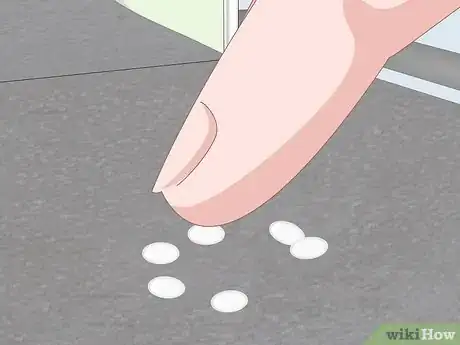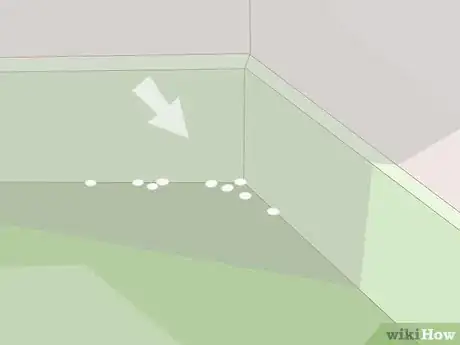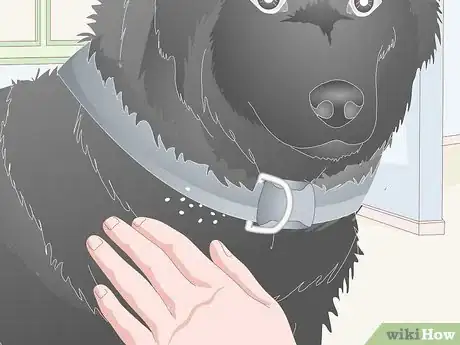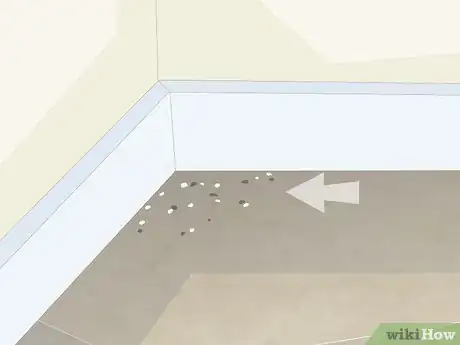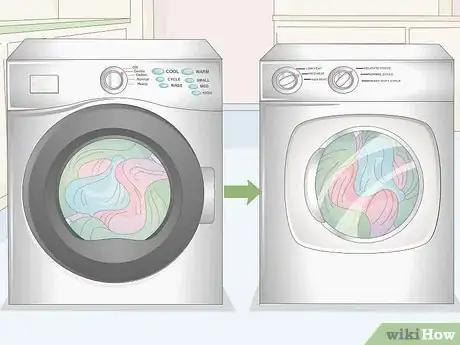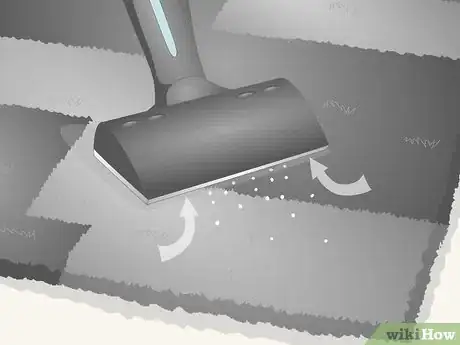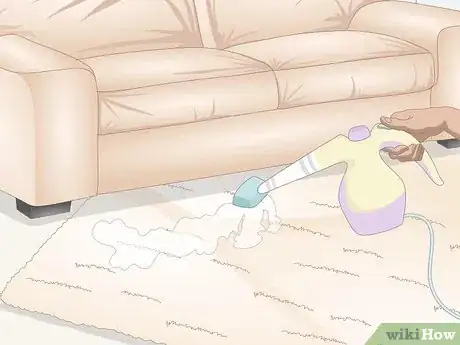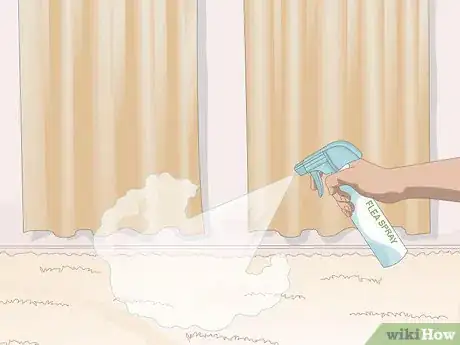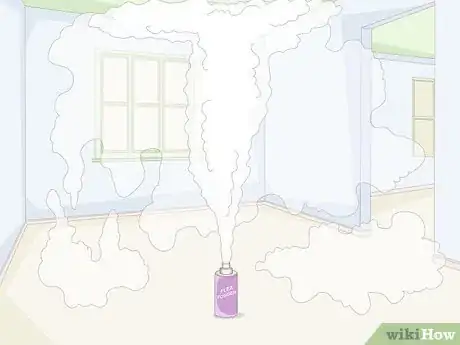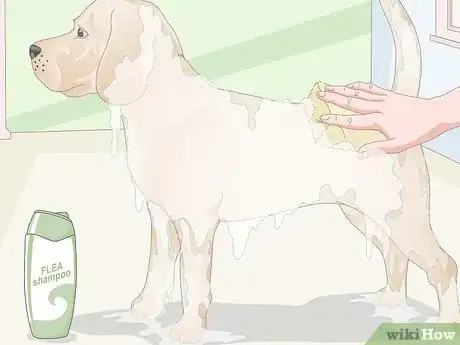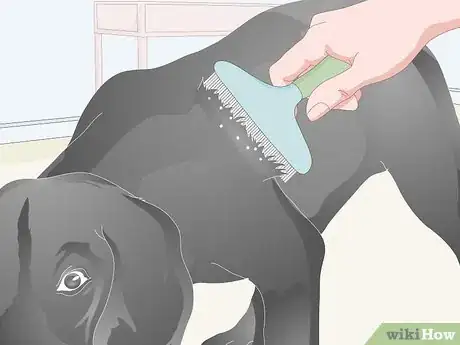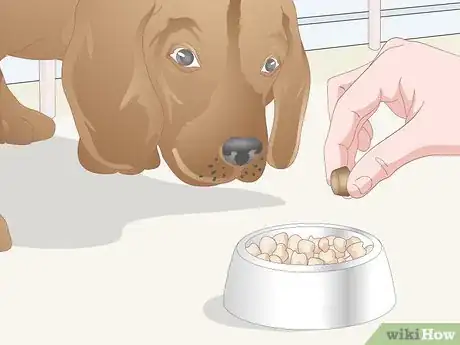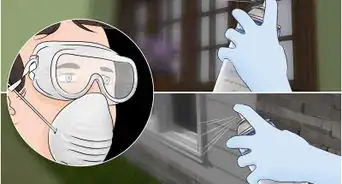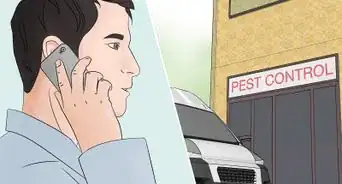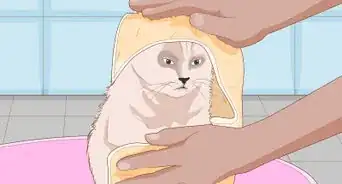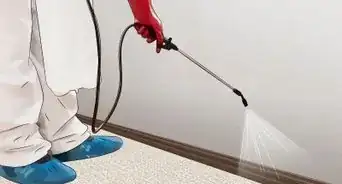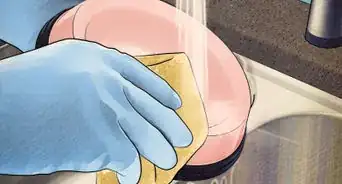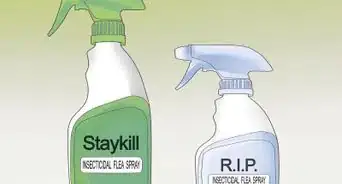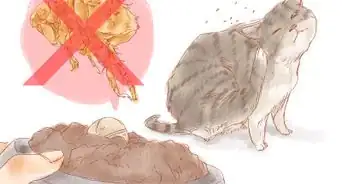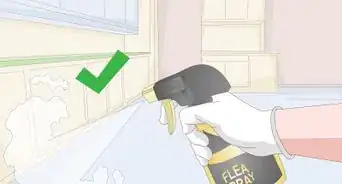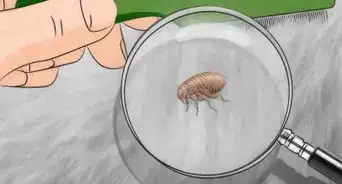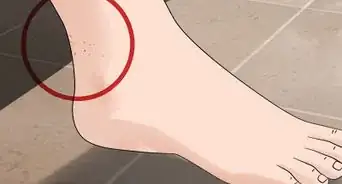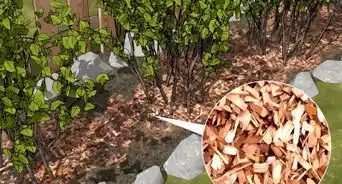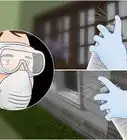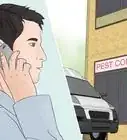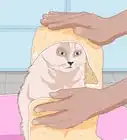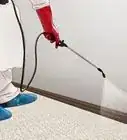This article was co-authored by Chris Parker and by wikiHow staff writer, Hunter Rising. Chris Parker is the Founder of Parker Eco Pest Control, a sustainable pest control service in Seattle, Washington. With over seven years of experience, Chris specializes in Integrated Pest Management and doesn’t use any chemicals for pest removal. He offers removal services for ants, rodents, fleas, spiders, wasps, and more. Chris is a certified Commercial Pesticide Applicator in Washington State and received his bachelor’s from the University of Washington.
This article has been viewed 74,303 times.
If fleas have gotten into your home, then it’s likely that they also laid eggs on your pet or in the carpet. Dealing with an infestation can feel overwhelming, but if you act quickly, you can kill the eggs before they hatch. If you find the eggs in your floors or on fabrics, you can wash and vacuum to remove the eggs. If your pet has fleas, then clean it thoroughly and give it medication to help fight against the infestation. With some hard work and perseverance, you can get rid of all the fleas in your home!
Steps
Detecting Flea Eggs
-
1Look for small white specks that resemble grains of salt. Flea eggs are white, slightly oblong in shape, and are about 1⁄2 millimetre (0.020 in) long. From a distance, the eggs may look like dandruff or grains of salt, so be sure to look at them closer if you notice them around your home. Hold the eggs up to a light to check that they’re slightly translucent; otherwise, the specks may not be eggs.[1]
- Eggs do not stick to fabrics or your pet, so they’re usually found on the floor or wherever they may have fallen off a pet.
- Use a magnifying glass if you have trouble finding any eggs since they’re small and can be easy to miss.
-
2Search in corners and crevices on the floor for the eggs. Flea eggs need to be in a dark, warm climate in order to hatch, so they’re usually laid in the carpet near baseboards or in the cracks in your floorboards. Thoroughly search through your home for any eggs using a flea comb and magnifying glass to work through the fibers of your carpet. Keep your room well-lit so you can see the eggs more easily. If you’re searching a room with a hard floor, use a small brush or a toothpick to work in between the floorboards and check for eggs.
- Look for areas in your home that don’t get a lot of foot traffic since fleas are more likely to lay their eggs there.
- Flea eggs are more likely to be in carpet than hardwood or tile, but you may still find a few there.
Advertisement -
3Check near your pet’s collar and hindquarters for eggs. If your pet has thick fur, then the eggs may not have fallen off of them. Use a flea comb close to your pet’s skin to search for any fleas or eggs that may be present. Focus on areas where your pet’s skin folds, such as their collar or near their hindquarters. If you find any fleas or eggs on your comb, immediately put the end of the comb in warm water to kill them.
- You may not find any flea eggs on your pet if it scratched them all off.
- Take off your pet’s collar and check if there are any fleas or eggs in the seams.
Tip: Keep pets that have fleas in one room of your home until you can control the problem so the infestation doesn’t spread anymore. Provide them with food and water, and let them outside when they need to.
-
4See if there are black and white specks in the same area for evidence of fleas. “Flea dirt” is a common name for flea feces and dried blood that’s commonly found near an infestation. Check in low traffic areas near baseboards or corners since that’s where fleas commonly stay. Flea dirt and eggs resemble specks of salt and pepper when they’re in the same area, so make note of any spots you find. [2]
- Flea dirt may stick to fabrics or furniture, so if you find any on your bedding or a couch, look on the floor under the area for eggs as well.
Killing Eggs on Floors and Fabric
-
1Wash and dry any fabrics that could have flea eggs. Put any blankets, bedding, or clothing that may have fleas or flea eggs in your washing machine as soon as you can. Use your standard laundry detergent and the hottest water that your fabric can handle to kill any living fleas as well as their eggs. As soon as the load in your washer is finished, move it to the dryer and use the highest heat setting as you can for your fabric.[3]
- Include any cushion covers, pet beds, washable rugs, soft toys, or anything else that could be harboring fleas.[4]
- Keep your clean clothes and bedding in a separate area of your home that’s away from the fleas or your pet so they don’t get infested again.
-
2Vacuum your carpet and furniture to remove any flea eggs. If you aren’t able to fit things in your washer, run your vacuum thoroughly over the area to suck up the fleas and eggs. Go over the same area multiple times to ensure you’ve vacuumed up as much as you can. Use the hose with a crevice tool attachment to get into corners and tight areas of your carpet and furniture.[5]
- Dispose of the vacuum’s contents or bag in an outdoor garbage can immediately when you’re finished, since fleas may be able to escape back into your home otherwise.
- Try to vacuum at least once a day while dealing with an infestation. Otherwise, the fleas may reappear quickly.[6]
-
3Use a steamer on thick fabrics or carpets to overheat them. Steamers heat up carpet and fabric enough where it kills any fleas or eggs in the area. Fill your steamer with water and turn it on to start heating it. Start in the corner furthest from the door and pull the steamer in straight lines across your room. Work slowly and be sure to overlap each line by about 1–2 inches (2.5–5.1 cm) so you don’t miss any spots.[7]
- After the carpet dries completely, vacuum it thoroughly to get rid of any dead fleas and eggs.
Tip: If you don’t have a carpet steamer, you may be able to rent one from big box or hardware stores.
-
4Apply a flea spray to any fabric or carpet to stop fleas from laying more eggs. Flea spray affects any young fleas living in your home and prevents them from laying any viable eggs as they mature. Shake the can of flea spray and work across your carpet and furniture in long strips so you don’t miss any areas. Let the spray dry on the carpet completely before walking on it again.[8]
- You can buy flea sprays at drugstores.
- You can use a natural spray if you have a small or medium infestation, but you may need to switch to chemical sprays if your home is heavily infested.
- If you have a pet, check with your veterinarian before spraying your carpet since it could contain harmful chemicals.
- If you're looking for an all-natural, non-toxic option to kill adult fleas, consider putting down diatomaceous earth.[9]
-
5Use a flea fogger if nothing else works in your home. Flea foggers produce a thick smoke that contains pesticides that kill roaches and eggs in your home. Make sure the windows in your home are closed and set the fogger in the area that has the worst part of the infestation. Activate the fogger and leave your home for the next 2-4 hours while the fogger works. After your fogger is finished working, then you can come back and open the windows to let it ventilate.[10]
- Read how large of an area your fogger covers and compare it to the size of your home. For example, if the fogger covers 375 square feet (34.8 m2) and your home is 1,000 square feet (93 m2), then you’ll need 3 foggers for the area.
- Don’t leave anybody or any pet in your home while the fogger is running since it produces harmful chemicals that are unsafe to breathe.
- Continue to clean and vacuum after you run the fogger to decrease your chances at reinfestation.
- Depending on the size of the infestation, you may need to fog your home multiple times.
- Flea bombs can be unsafe because they cover every surface in your home in pesticide.[11]
- If you use a flea bomb, be sure you cover your fish tanks—the pesticide chemicals could kill your fish.[12]
Removing Flea Eggs from Pets
-
1Wash your pet with flea shampoo to get rid of adult fleas and eggs. Flea shampoo is thick and sudsy, and it kills fleas and eggs soon after you apply it. Find a shampoo that’s formulated for your pet’s breed and then put your pet in the bathtub. Wet its fur to rinse off any loose eggs or fleas before rubbing in the flea shampoo. Make sure to cover your pet’s coat entirely with the shampoo so you don’t miss any areas. Let the shampoo sit for a minute before rinsing it out.[13]
- You can buy flea shampoo from your veterinarian or from pet stores.
- Be careful not to get the shampoo into your pet’s mouth or eyes since it may cause some irritation.
-
2Comb your pet with a flea comb to remove eggs from their fur. Start your comb near your pet’s head and push it as close to its skin as you can. Work gently in the natural direction that your pet’s fur grows towards its hind end. Once you lift the comb out of its fur, rinse it in hot, soapy water to get rid of any fleas or eggs you may have collected. Continue combing through all of your pet’s fur until you remove as many fleas and eggs as you can.[14]
- You can buy a flea comb from pet stores.
Tip: If you comb your pet inside, be sure to vacuum the area as soon as you’re finished.
-
3Give your pet flea medication to help prevent fleas from laying eggs. Talk to your pet’s veterinarian about what flea medication is available. Follow the directions on the package carefully and only give your pet the appropriate dose. When fleas bite your pet, the medication will prevent them from laying any eggs in the future so the infestation doesn’t spread.[15]
- Flea medication won’t directly kill flea eggs.
- Treating your pet is the most important thing you can do to help prevent future flea infestations in your home.[16]
Expert Q&A
Did you know you can get expert answers for this article?
Unlock expert answers by supporting wikiHow
-
QuestionHow do I get rid of flea eggs in my home?
 Chris ParkerChris Parker is the Founder of Parker Eco Pest Control, a sustainable pest control service in Seattle, Washington. With over seven years of experience, Chris specializes in Integrated Pest Management and doesn’t use any chemicals for pest removal. He offers removal services for ants, rodents, fleas, spiders, wasps, and more. Chris is a certified Commercial Pesticide Applicator in Washington State and received his bachelor’s from the University of Washington.
Chris ParkerChris Parker is the Founder of Parker Eco Pest Control, a sustainable pest control service in Seattle, Washington. With over seven years of experience, Chris specializes in Integrated Pest Management and doesn’t use any chemicals for pest removal. He offers removal services for ants, rodents, fleas, spiders, wasps, and more. Chris is a certified Commercial Pesticide Applicator in Washington State and received his bachelor’s from the University of Washington.
Founder, Parker Eco Pest Control First, you have to have the animals in the house treated. As long as they're a food source for the fleas, you're going to have a hard time getting rid of them. Then, do a very thorough combination of vacuuming and cleaning—vacuum all of your rugs every day and wash everything that you can wash in hot water. That includes your couch cushions, your bedding, dog bed, cat beds, and dog toys.
First, you have to have the animals in the house treated. As long as they're a food source for the fleas, you're going to have a hard time getting rid of them. Then, do a very thorough combination of vacuuming and cleaning—vacuum all of your rugs every day and wash everything that you can wash in hot water. That includes your couch cushions, your bedding, dog bed, cat beds, and dog toys.
Warnings
- Flea bites can cause itchiness or allergic reactions.⧼thumbs_response⧽
Things You’ll Need
- Flea comb
- Washer and dryer
- Vacuum
- Carpet steamer
- Flea spray
- Flea fogger
- Flea shampoo
- Bath
- Flea medication
References
- ↑ https://pesthacks.com/flea-eggs/
- ↑ https://pesthacks.com/flea-eggs/
- ↑ https://www.thebugsquad.com/fleas/flea-eggs/
- ↑ Chris Parker. Founder, Parker Eco Pest Control. Expert Interview. 15 January 2021.
- ↑ https://www.thebugsquad.com/fleas/flea-eggs/
- ↑ Chris Parker. Founder, Parker Eco Pest Control. Expert Interview. 15 January 2021.
- ↑ https://pesthacks.com/flea-eggs/
- ↑ https://www.thebugsquad.com/fleas/flea-eggs/
- ↑ Chris Parker. Founder, Parker Eco Pest Control. Expert Interview. 15 January 2021.
- ↑ https://www.thebugsquad.com/fleas/flea-eggs/
- ↑ Chris Parker. Founder, Parker Eco Pest Control. Expert Interview. 15 January 2021.
- ↑ Chris Parker. Founder, Parker Eco Pest Control. Expert Interview. 15 January 2021.
- ↑ https://www.thebugsquad.com/fleas/flea-eggs/
- ↑ https://www.thebugsquad.com/fleas/flea-eggs/
- ↑ https://youtu.be/eZqTDyOFmDA?t=40
- ↑ Chris Parker. Founder, Parker Eco Pest Control. Expert Interview. 15 January 2021.
